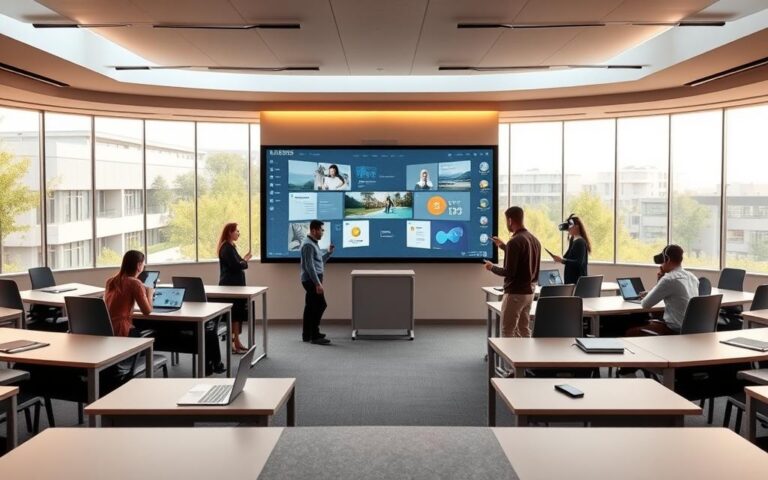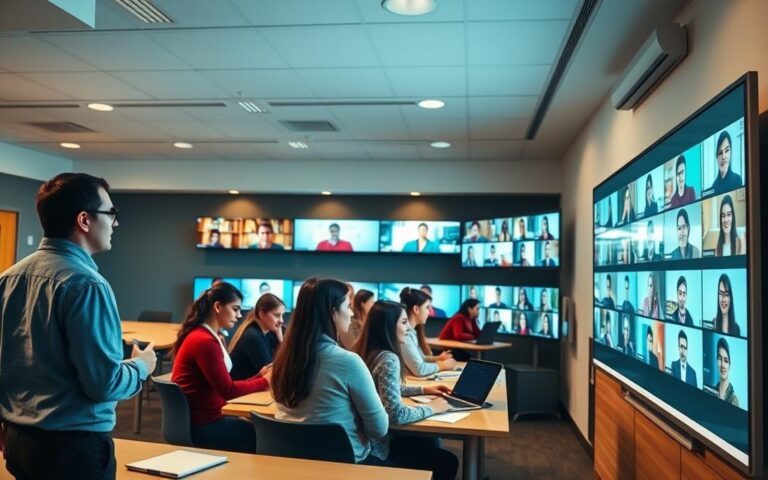This article looks at how critical thinking helps new leaders deal with complexity. It also improves decision-making and drives innovation. With fast-changing technology, global competition, and too much information, leaders must think analytically and strategically to succeed.
Places like the World Economic Forum say cognitive skills are key for the future. Employers in the U.S. also want problem-solving and clear thinking in their teams. So, teaching critical thinking to leaders is both urgent and essential.
Critical thinking is about making rational judgments, solving problems creatively, and thinking logically. It’s crucial for strategic thinking and helps leaders make smart choices even when it’s tough.
Next, we’ll explain what critical thinking is, its benefits for leaders, and how to teach it. We’ll also share examples, strategies, and look at the future of technology and its impact.
Readers will learn about critical thinking, how to improve analytical thinking, and see its impact in real companies. It’s for emerging leaders, HR folks, and teachers.
Understanding Critical Thinking and Its Importance
Leaders who think clearly make better choices under pressure. This section explains the core skills behind sound decision making. It shows why those skills matter in leadership roles.
Definition of Critical Thinking
Critical thinking is the disciplined process of actively and skillfully conceptualizing, analyzing, synthesizing, and evaluating information. It helps reach well-reasoned conclusions and solve problems. This definition aligns with frameworks used by the American Philosophical Association and the Paul-Elder model.
Key cognitive abilities in this definition include interpretation, analysis, inference, evaluation, explanation, and self-regulation. Each ability helps leaders turn data and opinions into clear, testable propositions.
Key Characteristics of Critical Thinkers
Critical thinkers show intellectual humility, open-mindedness, curiosity, and healthy skepticism. They ask probing questions and seek evidence before accepting claims.
Logical reasoning and analytical thinking appear as structured argumentation and careful source evaluation. Leaders who practice these skills notice assumptions, reduce bias, and create stronger plans.
Critical thinking differs from knowledge, creativity, or experience. Knowledge gives facts, creativity produces new options, experience offers context. Critical thinking ties those elements together. It helps leaders assess risk, communicate with stakeholders, and make defensible choices.
The Benefits of Critical Thinking for Leaders
Leaders who think critically do better in teams and projects. They make decisions faster and think more clearly. This leads to quicker action, fewer mistakes, and goals met sooner.
Improved Decision Making
Good leaders make decisions by defining problems, gathering data, and weighing options. Studies from places like Harvard Business School show this approach boosts performance.
Thinking critically helps avoid mistakes like seeing only what confirms our views. Leaders who think rationally question their assumptions and listen to others before acting.
Enhanced Problem-Solving Skills
When leaders mix analysis with creativity, they solve problems better. They use methods like root cause analysis and design thinking to find new solutions.
This approach gets teams to agree faster, cuts down on time to market, and improves results. It leads to better performance, innovation, and profits. This is true for all areas of a business.
Teams work better, operations are more efficient, and finance is stronger. These improvements make a company agile and ready for future challenges.
Critical Thinking in Leadership Development Programs
Good leadership programs teach people to handle complex problems. They mix classroom learning with real-world practice. This helps managers make informed decisions and act with confidence.
Integrating Critical Thinking Skills
Top business schools, like Harvard Business School, use real-life scenarios to teach critical thinking. They use experiential learning and simulations to build problem-solving skills.
On the job, leaders get to apply what they’ve learned in real situations. They get feedback from mentors and coaches. This helps them improve their decision-making over time.
Leadership programs should include tools like decision trees and probability. Practical tools like SWOT analysis and MCDA help turn analysis into action. Structured debates and reflective practice enhance strategic thinking.
Evaluation Methods for Critical Thinking
Evaluations should measure skills in real situations. Projects and simulations show how well someone applies critical thinking. Standardized tests, like the Watson-Glaser Critical Thinking Appraisal, help compare results.
360-degree feedback looks at decision quality from different perspectives. Rubrics score written work to highlight strengths and weaknesses. Pre and post tests measure cognitive growth during the program.
Measuring success in the workplace is a big challenge. Programs that use both numbers and stories give the best insights. They show how skills last over time.
Real-World Applications of Critical Thinking in Leadership
Real-world examples show how critical thinking changes outcomes. Short case studies highlight specific moves, data, and effects. They make abstract ideas practical for leaders who want to improve.
Case studies of successful leaders
Satya Nadella at Microsoft moved the company to cloud services. He analyzed market trends and used Azure experiments. This approach led to revenue growth and cultural change.
Indra Nooyi at PepsiCo used data and scenario planning to diversify. Her team tested healthier products and tracked sales. This improved problem-solving skills and long-term positioning.
Lessons learned from leadership failures
Ignoring data or dissent often leads to poor outcomes. In setbacks, teams fell into groupthink and overconfidence. Decisions without testing caused costly mistakes and damaged reputations.
Flawed strategies often come from limited views and missing metrics. To fix this, teams should review and use devil’s advocates. This reduces bias in decision-making.
Transferable insights and practical takeaways
- Encourage diverse perspectives to surface blind spots and improve analytical thinking.
- Adopt structured decision protocols to standardize how evidence is weighed in the decision-making process.
- Use iterative testing and scenario planning to sharpen problem-solving skills before scaling big bets.
- Monitor early warning metrics so teams can pivot fast when assumptions fail.
These examples and lessons give leaders concrete steps for critical thinking. They help create habits that reduce errors and increase success.
Cultivating a Critical Thinking Mindset
Leaders with a critical thinking mindset are curious and skeptical. They change their views when new evidence comes in. They focus on clear, relevant, and fair analysis in their daily decisions.
This mindset helps teams tackle complex tasks and solve problems creatively, even under pressure.
Strategies for Developing Critical Thinking
Use structured questioning to challenge assumptions and test conclusions. Premise-conclusion mapping helps see how evidence supports claims. These methods help teams identify weak reasoning.
Reflective journaling and after-action reviews improve self-regulation. Short written reflections after meetings or projects enhance logical reasoning over time.
Commit to deliberate practice. Tackle hard problems, ask for feedback, and improve your solutions. Reading and training across disciplines broaden your perspective and boost creative problem solving.
Encourage group exercises like devil’s advocate roles and premortem analyses. These team rituals spread skills and encourage dissent to refine plans.
Overcoming Barriers to Critical Thinking
Cognitive biases, pressure for quick decisions, groupthink, and information overload hinder clear thinking. Start bias training to recognize heuristics and use debiasing tactics.
Build a safe environment where people can share dissenting views without fear. Research by Amy Edmondson shows that safe teams find better solutions.
Adopt slow thinking practices like pause points and decision checklists. Curate information and rely on credible sources to reduce noise and support logical reasoning.
Use a staged development timeline. Short-term exercises teach techniques. Medium-term projects apply strategies in real work. Long-term cultural shifts embed habits for sustained creative problem solving.
| Focus Area | Action | Expected Result |
|---|---|---|
| Questioning | Socratic questioning and premise mapping | Clearer arguments and fewer hidden assumptions |
| Reflection | Journals and after-action reviews | Improved self-regulation and logical reasoning |
| Practice | Deliberate projects and peer feedback | Faster skill growth and practical creative problem solving |
| Team Habits | Devil’s advocate, red teams, premortems | Reduced groupthink and stronger decision quality |
| Bias Reduction | Debiasing training and alternative-hypothesis checks | Fewer errors from automatic thinking and better outcomes |
| Culture | Psychological safety and information curation | More open debate and reliable data-driven choices |
The Relationship Between Critical Thinking and Emotional Intelligence
Leaders with strong reasoning and emotional awareness guide teams smoothly through tough times. Emotional intelligence helps them understand situations better. Critical thinking guides their actions, making decisions better and improving thinking skills.
Understanding Emotional Intelligence in Leadership
Emotional intelligence, as Daniel Goleman said, includes self-awareness, self-regulation, motivation, empathy, and social skills. Self-awareness lets leaders recognize their feelings before they affect others. Self-regulation stops impulsive actions that damage trust.
Motivation keeps focus on long-term goals without hurting team spirit. Empathy and social skills help leaders connect and influence others well.
How Critical Thinking Enhances Emotional Awareness
Critical thinking teaches leaders to question their assumptions and separate facts from feelings. This habit reduces bias when listening to team feedback. A leader who thinks critically makes better judgments about intentions and outcomes.
Self-reflection tools help leaders understand their triggers. Journaling and feedback help clarify why they react a certain way. This practice reduces impulsive decisions in meetings.
Cognitive appraisal techniques help leaders understand emotional situations better. By analyzing behavior, cause, and outcome, empathy becomes evidence-based. This approach strengthens emotional awareness while keeping logic in mind.
Evidence-based empathy combines listening with data. Surveys, metrics, and notes validate impressions. Leaders who mix emotional cues with data make decisions that are both practical and compassionate.
Balanced leadership leads to better conflict resolution and higher trust. Teams perform better when leaders use critical thinking and emotional intelligence.
Practical Exercises to Integrate Both Skills
Try perspective-taking exercises where team members explain a problem from another role’s view. Then, do short emotion labeling: name the feeling, the trigger, and the need. Follow this with a structured decision check: list facts, assumptions, and biases.
Use weekly reflection prompts. Ask: What emotion influenced my choice? What evidence supports that feeling? What alternative explanations exist? These prompts sharpen emotional awareness and cognitive abilities over time.
| Practice | What It Trains | Expected Outcome |
|---|---|---|
| Perspective-taking role play | Empathy and hypothesis testing | Broader understanding of stakeholder views |
| Emotion labeling in meetings | Self-awareness and clear expression | Fewer misunderstandings, calmer interactions |
| Structured decision checklist | Fact-assessment and bias reduction | More transparent decision-making process |
| Data-informed listening | Evidence-based empathy | Solutions that match team needs and metrics |
| Weekly reflective journaling | Self-regulation and cognitive abilities | Reduced reactivity and clearer priorities |
Teaching Critical Thinking in Educational Institutions
Schools, colleges, and professional programs in the U.S. aim to teach critical thinking. This is crucial for future leaders. They will face complex workplaces that need quick decisions, ethical choices, and problem-solving skills.
By combining coursework with hands-on learning, students can apply what they learn. This helps them move from theory to real-world practice.
Importance of Curriculum Design
Curriculum design should build on previous knowledge. It starts with the basics of logic and argumentation. Then, it moves to applying these skills in real-world scenarios.
Liberal arts colleges and business schools show how this works. Business schools use case methods to teach decision-making. Liberal arts programs focus on analytical thinking through texts and data.
Combining STEM, humanities, and social sciences in courses helps transfer skills. When data literacy and ethical reasoning are part of assessments, students learn to evaluate evidence and consequences. This way, they can analyze complex problems.
Engaging Students through Practical Exercises
Active learning keeps students interested. Case studies and simulations mimic real-world leadership challenges. This lets learners test their choices under pressure.
Problem-based learning requires students to ask questions, form hypotheses, and solve problems. This sharpens analytical thinking and problem-solving skills.
Cross-disciplinary projects encourage students to work with peers from different fields. This builds strategic thinking and creative problem solving. Technology tools like data analysis software and online debate platforms provide hands-on experience with real data and decisions.
Partnerships with industry offer internships, consulting projects, and guest lectures. Companies like General Electric and Deloitte share their decision-making processes. This shows how classroom learning applies to real-world needs.
Equity and access are key in teaching critical thinking. Using culturally responsive materials and flexible assessments helps diverse learners. Inclusive activities ensure more students can practice problem-solving and become confident analytical thinkers.
The Future of Leadership in a Complex World
The world is changing fast, thanks to AI, automation, and more. Leaders need to think critically and strategically. They must spot patterns, question what they know, and plan for the future.

Adapting to Rapid Change
Leaders must make quick, smart choices. They need to keep learning and planning for different scenarios. This way, they can make decisions fast and avoid delays.
Critical thinking helps leaders sort through new information. Strategic thinking guides them on how to use resources wisely. Building a strong team helps them bounce back from setbacks.
The Role of Technology in Critical Thinking
Technology is a big help for leaders. AI and analytics tools find trends and predict what’s next. This lets leaders focus on the big picture and how to make a difference.
But, technology has its risks. Leaders must watch out for bias and understand how models work. They should check the facts before making decisions.
- Use predictive analytics for pattern detection, not as final verdicts.
- Combine human judgment with automated insights to improve decisions.
- Train teams in data literacy so they can question and explain results.
Leaders need to use technology wisely. They should solve complex problems, think about systems, and understand digital and ethical issues. These skills are built on strong critical and strategic thinking.
Conclusion: Embracing Critical Thinking for Effective Leadership
Critical thinking is at the heart of this article. It includes a clear definition, key components, and how it helps in decision-making. It also talks about teaching and cultivating this skill, with real-world examples.
It shows how critical thinking works with emotional intelligence and how technology will shape it in the future. Leaders who use critical thinking improve their problem-solving and rational thinking. They make better decisions and lead their teams more effectively.
Call to Action for Emerging Leaders
Start by reflecting on your decisions every day. Use simple checklists to track your choices. Look for projects that involve working with different teams to practice your reasoning.
Take courses from places like Harvard Business School Online or Coursera. Use feedback from 360 reviews and mentors to improve your problem-solving skills. This will help you grow as a leader over time.
Final Thoughts on Leadership Growth
Organizations should make critical thinking a part of hiring, leadership development, and reviews. HR and executives can create assessments and rewards for those who make evidence-based decisions. This is a long-term investment in leadership growth.
It leads to more innovative teams and resilient organizations. Start small, stay curious, and make critical thinking a daily habit. This will improve your rational thinking and decision-making.



